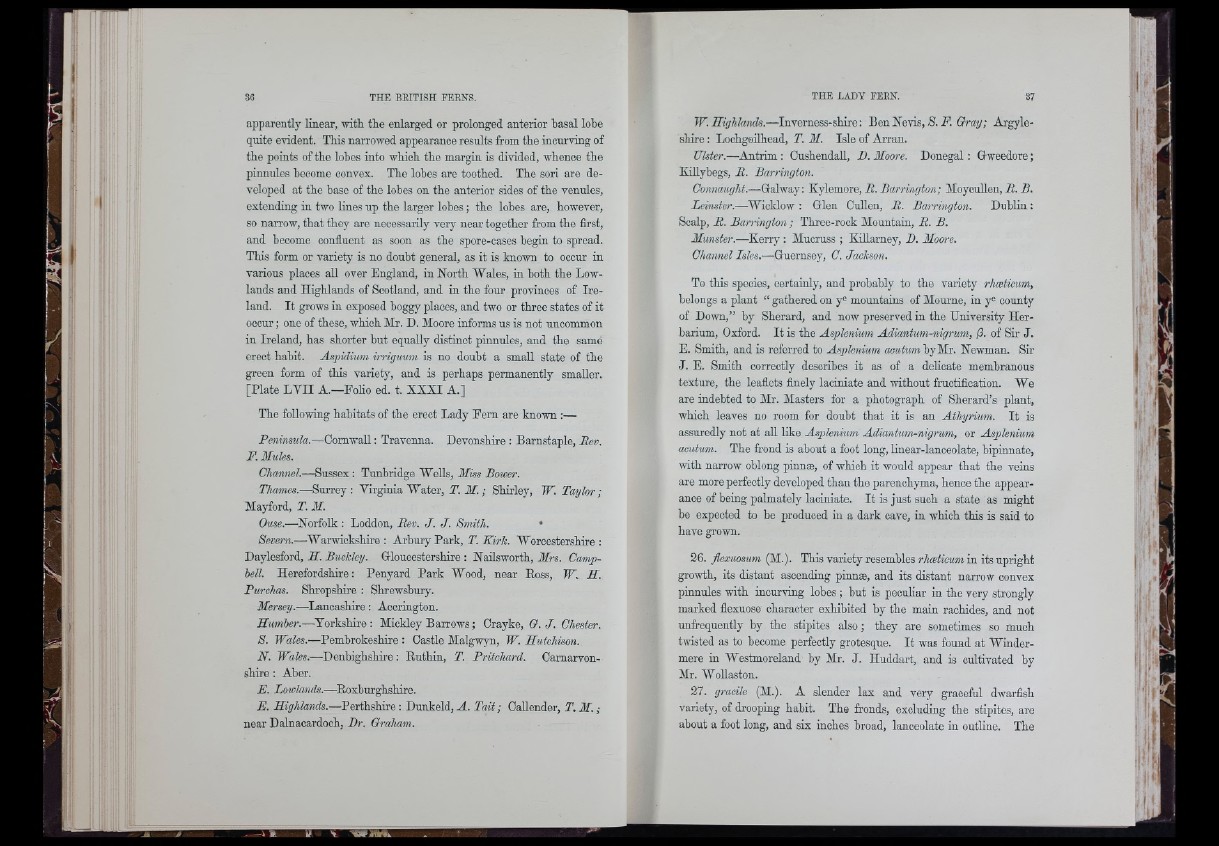
apparently linear, witli the enlarged or prolonged anterior basal lobe
quite evident. This narrowed appearance results from the incurving of
the points of the lobes into which the margin is divided, whence the
pinnules become convex. The lobes are toothed. The sori are developed
at the base of the lobes on the anterior sides of the venules,
extending in two lines up the larger lobes; the lobes are, however,
so narrow, that they are necessarily very near together from the first,
and become confluent as soon as the spore-cases begin to spread.
This form or variety is no doubt general, as it is known to occur in
various places all over England, in North Wales, in both the Lowlands
and Highlands of Scotland, and in the four provinces of Ireland.
It grows in exposed boggy places, and two or three states of it
occur; one of these, which Mr. D. Moore informs us is not uncommon
in Ireland, has shorter but equally distinct pinnules, and the samé
erect habit. Aspidium irriguum is no doubt a small state of the
green form of this variety, and is perhaps permanently smaller.
[Plate LVII A.—FoHo ed. t. XXXI A.]
The following habitats of the erect Lady Fern are known :—
Peninsula.—Cornwall: Travenna. Devonshire ; Barnstaple, Rev.
F. Mules.
Channel.—Sussex: Tunbridge WeUs, Miss Bower.
Thames.—Surrey; Virginia Water, T .M .; Shirley, W. Taylor;
Mayford, T. M.
Ouse.—^NorfoIk : Loddon, Bev. J. J. Smith. •
Severn.—•Warwickshire ; Arhury Park, T. Kirk. Worcestershire :
Daylesford, H. Buekley. Gloucestershire : Naüsworth, Mrs. Camphell.
Herefordshire: Penyard Park Wood, near Boss, W.. H.
Purehas. Shropshire : Shrewsbury.
Mersey.-—-Lancashire: Aocrington.
Uumher.—Yorkshire : Mickley Barrows; Crayke, O. J. Chester.
8 . Wales.— Pembrokeshire : Castle Malgwyn, W. Hutchison.
N. Wales.—Denbighshire: Euthin, T. Pritchard. Carnarvonshire
: Aber.
B. Lowlands.—Eoxburghshire.
E. Highlands.—Perthshire : Dunkeld, A. Tait; Callender, T. M .;
near Dalnacardooh, Dr. Graham.
W. Highlands.— Inverness-shire: Ben Nevis, S . Jd Argyleshire
: Lochgsühead, T. M. Isle of Arran.
Ulster.—Antrim : CushendaU, B. Moore. Donegal : Gweedore ;
Killybegs, B. Barrington.
Connaught.— Galway: Kylemore, B. Barrington; MoyeuUen, R . B.
Leinster.—Wicklow : Glen Cullen, B. Barrington. Dublin :
Scalp, B. Barrington ; Three-rook Mountain, B. B.
Munster.—Kerry : Mucruss ; KiUarney, B. Moore.
Channel Isles.— Guernsey, 0 . Jackson.
To this species, certainly, and probably to the variety rhæticum.,
belongs a plant “ gathered on mountains of Mourne, in y® county
of Down,” by Sherard, and now preserved in the University Herbarium,
Oxford. It is the Asplenium Adiantum-nigrum, /3. of Sir J.
E. Smith, and is referred to Asplenium acutumhjMx. Newman. Sir
J. E. Smith correctly describes it as of a delicate membranous
texture, the leaflets finely laoiniate and without fruotifioation. We
are indebted to Mr. Masters for a photograph of Sherard’s plant,
which leaves no room for doubt that it is an Athyrium. It is
assuredly not at aH hke Aspknium Adiantum-nigrum, or Asplenium
acutum. The frond is about a foot long, hnear-lanoeolate, bipinnate,
with narrow oblong pinnæ, of which it would appear that the veins
are more perfectly developed than the parenchyma, hence the appearance
of being palmately laoiniate. It is just such a state as might
be expected to be produced in a dark cave, in which this is said to
have grown.
26. flexuosum (M.). This variety resembles rhæticum in its upright
growth, its distant ascending pinnæ, and its distant narrow convex
pinnules with incurving lobes ; but is peouhar in the very strongly
marked flexuose character exhibited by tbe main rachides, and not
unfrequently by the stipites also ; they are sometimes so much
twisted as to become perfectly grotesque. It was found at Winder-
mere in Westmoreland by Mr. J. Huddart, and is cultivated by
Mr. WoUaston.
27. gracile (M.). A slender lax and very graceful dwarfish
variety, of drooping habit. The fronds, excluding the stipites, are
about a foot long, and six inches broad, lanceolate in outline. The
I ‘
'I
*'•
'•M
l:<i